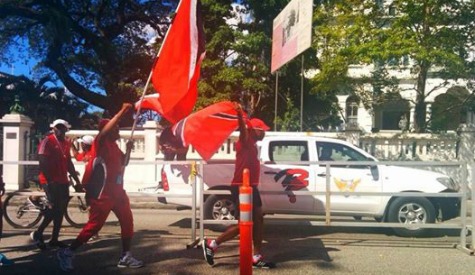 Olympic icon offers Montreal gold to 10golds24 fund
Olympic icon offers Montreal gold to 10golds24 fundHasely Crawford put his Olympic gold medal where his mouth is yesterday.
Catching the audience at the atrium of the Guardian Group offices in Westmoorings completely by surprise, the 1976 Montreal 100 metres champion said he would put up the medal and the gear he wore on that historic day to be leased, in support of the Trinidad and Tobago Olympic Committee’s #10golds24 Athlete Welfare and Preparation Fund.
“I am offering my Olympic gold medal, my jersey, my pants, the socks and the shoes to you, the Olympic Association,” Crawford said, addressing a stunned TTOC president Brian Lewis at the head table. “You need to work out some form of arrangement where it can be leased to support our young people.”
Crawford’s words were followed by sustained applause from the gathering that was there to witness a cheque presentation by the Guardian Group in support of the Olympic Committee’s #10golds24 project.
Before presentation time arrived however, Crawford made a passionate plea for public support for the Fund.
Recalling his own personal struggles in the build-up to his Montreal triumph, he said: “A lot of people do not understand what an athlete goes through, especially to win an Olympic medal.”
He then gave examples of the current need for corporate help involving, “two of our young, budding athletes, 16, 17,” who, “personally I feel they will be world beaters in time to come.”
Crawford recalled: “Their coach came to me and said, Mr Crawford, one of these athletes needs to have an MRI but he doesn’t have the funding...I made some enquiries and it was done.
“He brought another athlete, we talking about Olympic potentials, she did not have a proper pair of shoes or equipment to train. I’m saying these things so you all could understand how important these things are...
“Ladies and gentlemen, to win an Olympic gold medal is not easy. You need a lot of support, especially our younger athletes...The reason I stay with it is that we have a lot of very, very poor athletes. If we really want to win these 10 gold medals, we need to really come forward and support Mr Lewis.”
Speaking to the Express later about his offer, Crawford elaborated: “I am offering to them (for the medal and gear) to be leased to some company and the proceeds will go towards the Olympic Association.
He added: “It doesn’t make sense me having it in my house, it’s for Trinidad and Tobago.”
Crawford said he has other projects in mind, the full details of which are still to be worked out.
In response, a still shocked Olympic Committee president Brian Lewis, who walked Sunday’s T&T International Marathon to kick off the Welfare and Preparation Fund said: “The gesture is awesome. I’m almost speechless at what Hasely Crawford today has offered to do, not only in support of not only the provision of 10 Olympic medals by the year 2024, but the Athlete Welfare and Preparation Fund. I didn’t come here anticipating that was going to happen.”
 Port-of-Spain, Trinidad January 27, 2015:
Port-of-Spain, Trinidad January 27, 2015:
 Olympic icon offers Montreal gold to 10golds24 fund
Olympic icon offers Montreal gold to 10golds24 fund Colombia’s long distance runner Juan Cardona Rios stopped the clock at two hours, 21 minutes and 13 seconds (2:21.13) to win the 2015 edition of the T&T International Marathon which started at St Mary’s Junction, Freeport and concluded at Whitehall at the Queen’s Park Savannah, Port-of-Spain yesterday.
Colombia’s long distance runner Juan Cardona Rios stopped the clock at two hours, 21 minutes and 13 seconds (2:21.13) to win the 2015 edition of the T&T International Marathon which started at St Mary’s Junction, Freeport and concluded at Whitehall at the Queen’s Park Savannah, Port-of-Spain yesterday. Trinidad and Tobago Olympic Committee (TTOC) President Brian Lewis completed the Trinidad and Tobago International marathon today, as he aimed to raise awareness and funds for the newly launched #10gold24 Athlete Welfare and Preparation initiative.
Trinidad and Tobago Olympic Committee (TTOC) President Brian Lewis completed the Trinidad and Tobago International marathon today, as he aimed to raise awareness and funds for the newly launched #10gold24 Athlete Welfare and Preparation initiative. "I had to dig real deep," said Lewis, who completed the marathon draped in the national flag.
"I had to dig real deep," said Lewis, who completed the marathon draped in the national flag. Veteran marathoner Curtis Cox is urging racing officials to make changes that will help revive the discipline locally.
Veteran marathoner Curtis Cox is urging racing officials to make changes that will help revive the discipline locally. THE LAST Olympic Games of the Twentieth Century were held in Atlanta in 1996 and Trinidad and Tobago's 13 athletes were among those who witnessed another exceptional opening ceremony created and choreographed by one of this country's top Carnival designers, Peter Minshall.
THE LAST Olympic Games of the Twentieth Century were held in Atlanta in 1996 and Trinidad and Tobago's 13 athletes were among those who witnessed another exceptional opening ceremony created and choreographed by one of this country's top Carnival designers, Peter Minshall.